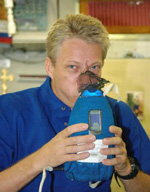This is an archive of information released in the past.
Disclaimer: It may contain broken links or outdated information. Some parts may not function in current web browsers.
*Visit https://humans-in-space.jaxa.jp/en/ for the latest information.

Benefits for Humanity
- Benefits for Humanity
- Program Science Forum
- International Partners
Are You Asthmatic? Your New Helper Comes From Space.
European Space Agency
Kalle, a 10-year-old boy, is already in favor of space technology. In the future, he could control his asthma with a small device also used by crew members on board the International Space Station. Because of it, he knows almost everything about nitric oxide - an important gas we all breathe out.

Former ESA astronaut Thomas Reiter undertaking science activities for the Nitric Oxide Analyzer (NOA) experiment in 2006. (Image: ESA)
Nitric oxide, or nitrogen monoxide, as it is properly called, is both a good and bad molecule, found almost everywhere as an air pollutant that is produced by vehicle exhaust and industrial processes burning fuel. Nitric oxide is a contributor to the damage of the ozone layer and easily converts into nitric acid - which may fall as acid rain.
Intriguingly, tiny amounts of nitric oxide are released locally in inflamed tissue of humans and other mammals. Tracing it back to its source can reveal different diseases.
In people with asthma, inflammation in the lung adds nitric oxide to exhaled air. Measuring the gas can help to diagnose the disease may prevent attacks if the levels of nitric oxide indicate that medication should be adjusted.
Nitric oxide is also an interesting molecule on the space station. Dust and small particles floating around in weightlessness can be inhaled by the astronauts, possibly triggering inflammation of the airways. It also plays a role in decompression sickness that may arise from spacewalks.
The European Space Agency, or ESA, uses a lightweight, easy-to-use, accurate device for measuring nitric oxide in exhaled air. The aim is to investigate possible airway inflammation in astronauts and act before it becomes a health problem.
Following its development by the Swedish company Aerocrine AB and ESA, the device has been found beneficial in space exploration and everyday use on Earth.
NIOX MINOクA迸is now used by patients like Kalle at health centers. They can monitor levels of asthma control and the efficiency of medication - leading to more accurate dosing, reduced attacks and improved quality of life.
For further information, please contact:
Lars Karlsson and Lars Gustafsson
Karoliniska Institutet, Stockholm, Sweden
Dept of Physiology and Pharmacology
Karolinska Institutet
Nanna Svartz vクJg 2
S-171 77 Stockholm, Sweden
Tel. +46 8 524 868 90
Email: Lars.Karlsson@ki.se
| Copyright 2007 Japan Aerospace Exploration Agency | Site Policy |







